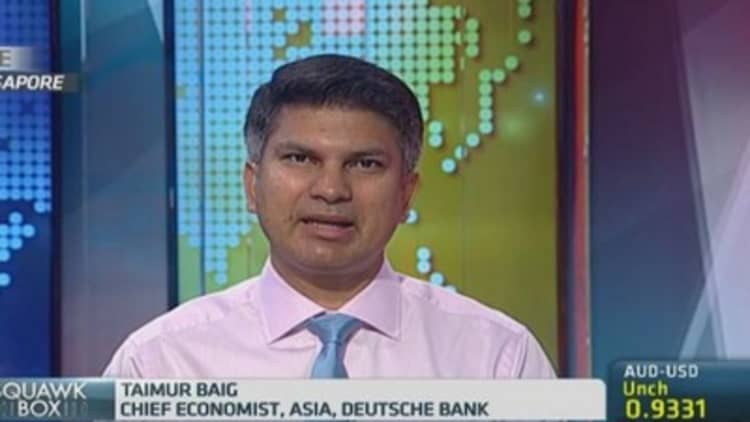
There's more to blossoming ties between the Indian and Japanese prime ministers than counterbalancing the rise of China, analysts say.
"India right now is shopping for money. That to me trumps any longer geo-political considerations, especially with respect to China. I'm sure India also wants very strong relations with China as it is India's largest trading partner," said Taimur Baig, chief Asia economist at Deutsche Bank.
"There are broader issues down the road about supplanting China as a manufacturing hub, but that's not today's story. That's years from now. First off is getting the macro house in order as far as India's concerned," he said.
Read MoreIndia and Japan send signal with bear hug
Narendra Modi made a five-day visit to Tokyo last week, his first major trip to a foreign country since becoming India's prime minister in May. Stronger ties between India and Japan are rooted in an over two-year old friendship between Modi and Japanese Prime Minister Shinzo Abe that began in 2012 when Modi visited Japan during his role as Gujarat's Chief Minister. The leaders hold similar conservative-nationalistic, pro-business views.
A united front
Defense deals overshadowed investment news, fueling speculation that Japan and India aim to form a united front amid China's increasingly aggressive maritime offense in the South and East China Seas.
Read MoreIs India 'holding a gun to its own head?'
Modi lashed out at what he called the "18th century" expansionary ways of some countries which "encroach and enter the seas of others," during his visit, a likely reference to Beijing.
On Monday, the leaders agreed to hold regular maritime exercises and to accelerate talks about the potential sale of Japanese aircraft to India's navy; this would mark Japan's first overseas military sale in nearly 50 years.
Seeking investment
While defense deals were front and center, Modi also sought increased investment from Japan - its fourth-largest foreign-direct investor, according to data from India's Ministry of Commerce and Industry.
"Modi went to Tokyo with a very clear message for Japanese businesses that he was going to address the country's labyrinth of regulatory and tax complications that get in the way of foreign direct investment, which the Japanese business community has scratched their heads over for a long time," said Sheila Smith, senior fellow for Japan studies at the Council for Foreign Relations.

If the Japan Credit Ratings Agency is more favorably pre-disposed to looking at India's macro outlook there's a greater chance that a higher rating will be assigned, reducing the cost of financing for Japanese corporates into India, Deutsche Bank's Baig said.
Read More
On Monday, Japan pledged to double private and public investment in India over the next five years to $35 billion.
Jealous much?
State-run newspaper China Daily accused Abe of "dividing" India and China on Monday, stating that Indo-Japan ties face "huge uncertainty" in view of rising cooperation between China and India and the BRICS (Brazil, Russia, India, China and South Africa) generally.
"Beijing's improving maritime strategies and the development of China-India strategic relations will inevitably exert far-reaching influence upon Japan's strategic resources, channels and markets," the paper said.
The article also questioned why India would sign deals with Japan that could potentially affect China ahead of Modi's state visit to Beijing later this month.
Read MoreIce to... rice? India's twist to the bucket challenge
Still, Baig expects Modi to cosy up to Chinese leader Xi Jinping.
"Our view is that Modi wants to pursue and East Asian model of development: Pushing up the savings rate which then becomes a source of large investment pool but also importing capital from the rest of the world to set up large manufacturing facilities to provide employment for Indians. If that is a model India wants to follow, then Japan is example number 1 and China is example number 2."

